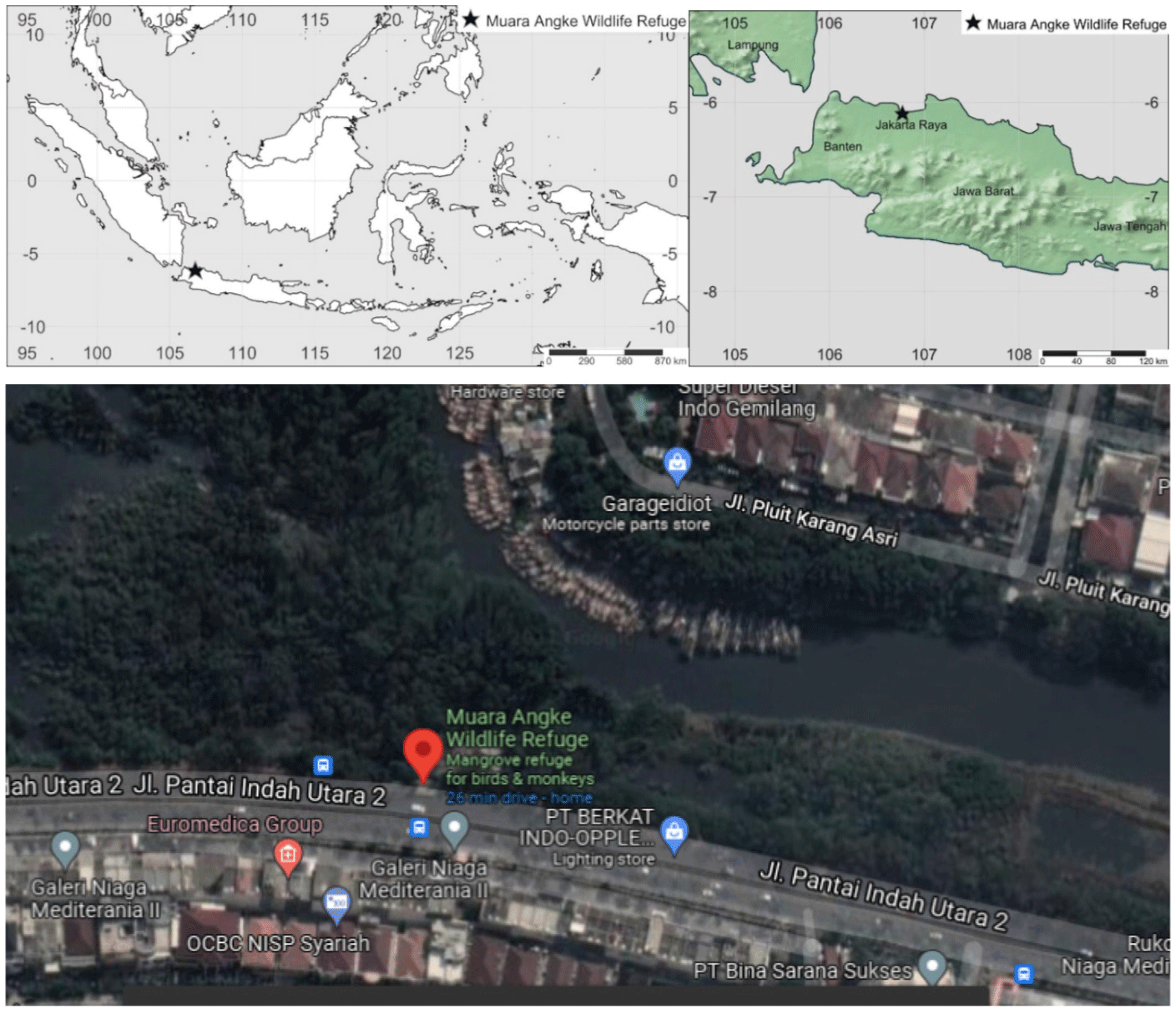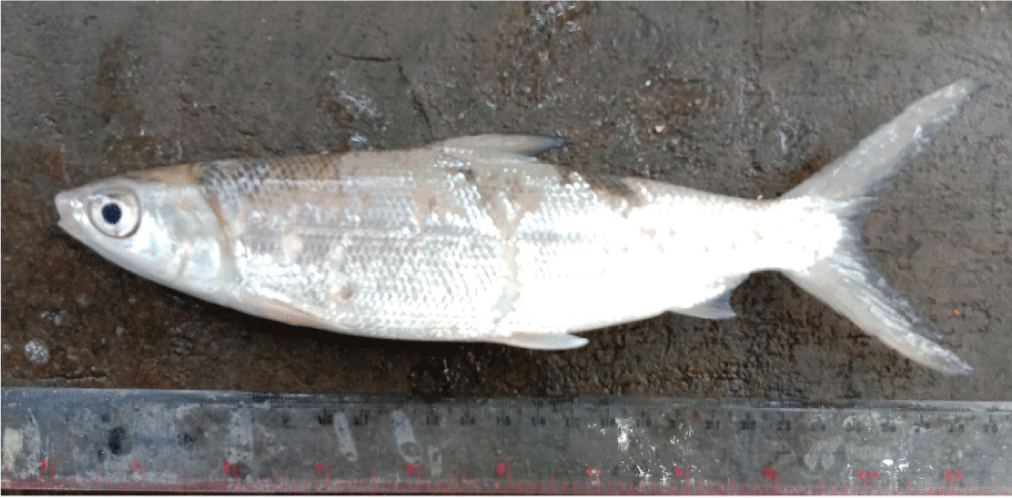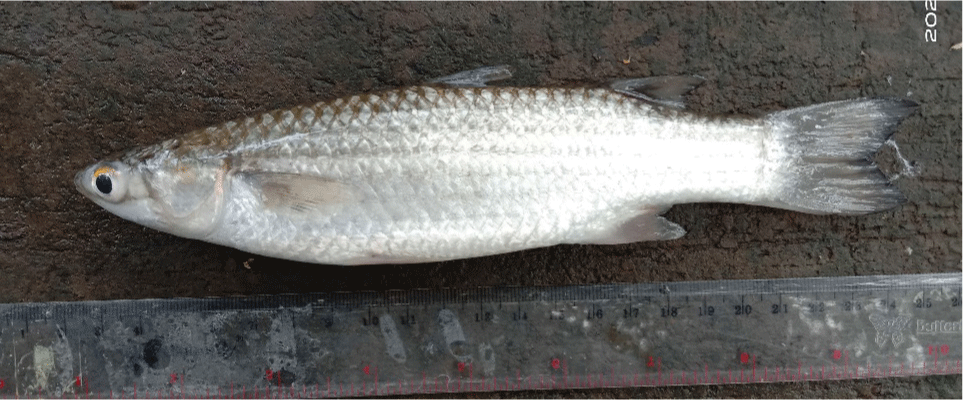Introduction
A Wildlife Reserve is a forest area of a nature reserve, a place to live and protect animals with unique and useful values (Budiman et al., 2017). The Muara Angke Wildlife Reserve is one of 75 sanctuary areas in Indonesia. The area is within the Kapuk Muara and Pluit sub-districts, Penjaringan District, and North Jakarta Municipality. The conservation area was initially incorporated into protected forests, nature parks, and wildlife sanctuaries, totaling 170.60 ha. In addition, the Wildlife Reserve has the status of a Nature Reserve, according to the decision of the Governor-General of the Dutch East Indies Number 24 dated June 18, 1939, which has an area of 15.40 hectares. Then, based on the Minister of Forestry and Plantations Decree Number: 097/KPTS-II/1998, its status changed to Muara Angke Wildlife Reserve with an area of 25.02 ha, which is located at coordinates 06o06’–06o10’ South Latitude and 106o43’–106o48’ BT. Furthermore, for the location of the boundaries of the area, namely, to the north it is bordered by the Angke Kapuk Protection Forest, then to the south by the PT Mandara Permai area, to the east by the Angke River, and the west by the Pantai Indah Kapuk (PIK) housing (BKSDA, 2015; Mayalanda et al., 2014; PPLH, 2000, unreported document).
This reserve area stores and is inhabited by various flora and fauna. Most of the flora are mangrove species, including api-api Avicennia spp., bakau Rhizophora apiculata and Rhizophora mucronata, buta-buta Exoecaria agallocha, kelakai Stenochlaena palustris, nipah Nypha fruticans, perumpung Phragmites karka, and pidada Sonneratia caseolaris (Karminarsih, 2007; Mayalanda et al., 2014; Mujadid et al., 2020; Santoso et al., 2012). In addition, there are plants on land that tend to be dry, namely beringin Ficus benyamina, nyamplung Calophyllum inophyllum, saga Adenanthera pavonina, and waru laut Hibiscus tiliaceus (Mujadid et al., 2020), weeds Acanthus ilicifolius and Crynodon dactylon, also gulma Acrosticha aureum (Karminarsih, 2007; Purwoko et al., 2015; Supartha et al., 2002).
The fauna recorded was 67 bird species, including 31 waterbird species (Noor, 2002; Supartha et al., 2002). In addition, Mayalanda et al. (2014) added that 15 protected bird species exist. Direct observation of mammals in the sanctuary shows that the macaque species of Macaca fascicularis live in groups, and Mujadid et al. (2020) informed that five mammal families are in the area. Then, for the type of herpetofauna, there are as many as 22 species (Mayalanda et al., 2014), and from observations of the Varanus salvator monitor lizard often found around swamp areas and the Angke River, it is suspected that they are looking for fish as food.
Furthermore, Muara Angke Wildlife Reserve is Indonesia’s smallest reserve when compared to other reserves in Indonesia. This reserve is located north of the heart of the capital city of Jakarta, with various environmental pressures around it. The reserve is inhabited by a variety of fish species that can adapt to saline waters. As a note, research on fish diversity has not been widely carried out, and the data after being traced were only in 2012 and 2013. Sources describing new fish ichthyofauna on a large scale were summarized in the book Freshwater Fishes of Western Indonesia and Sulawesi in 1993, later Monographed in 2013, entitled The Fishes of the Inland Waters of Southeast Asia: A Catalog and Core Bibliography of the Fishes Known to Occur in Freshwaters, Mangroves, and Estuaries (Kottelat, 2013; Kottelat et al., 1993). This paper aims to provide an ichthyological summary of fish from the Muara Angke Wildlife Reserve. The types of fish recorded are new but may not be complete because research in this sanctuary will continue to be carried out in the coming years. Several additional species from the Cyprinidae family have never been recorded before but are still in one distribution trajectory. In addition, some new families have emerged that have not been found in previous literature. The validation of fish species has now become synonymous. The expected results are to find out the record of renewable fish species in the Muara Angke Wildlife Reserve so that it can be used as data for policymakers to preserve fauna, especially the fish that inhabit it.
Materials and Methods
Research compiled scientific phylogeny and naming, with various valid sources (Allen et al., 2002; Fricke et al., 2018; Kottelat, 2013; Kottelat et al., 1993; Kullander, 2003; Weber, 1916). The types studied are literature studies and the results of fieldwork previously carried out in the Muara Angke Wildlire Reserve (Fig. 1). The method of fieldwork carried out refers to Suhardjono (1999), which includes the installation of gill nets with diameters of one inch, and two inches, and stocking nets with a diameter of 1 cm and 2 cm. The collected fish samples was fixed using a 4% formalin solution and labeled according to the name of the type and research location, then taken to the Biodiversity Laboratory under the National Research and Innovation Agency Republic of Indonesia. In the laboratory, the sample is washed with running water and immersed in 70% alcohol as a permanent preserve. Then the fish is ready to be named according to the identification key book. The procedure have followed the standards for fauna diversity data collection issued by LIPI (Indonesian Institute of Sciences) (Prijono et al., 2004).
As for more detail and validity in knowing the fish type, it matches the fish stored previously at the Bogor Zoological Museum (MZB). In the MZB key fish species or Holotype and Paratype as a comparison of fish samples to be studied.
Most of the fish species in this reserve are euryhaline, which is tolerant of saline waters. The recorded environment shows that fish can live in the sea, fresh and brackish. In the highway life cycle, it is known that there are 5 types of highway life patterns, and some are not migratory. Anadromus: species with adult size in marine waters, then migrate to freshwater to spawn (Chaparro-Pedraza & de Roos, 2019). Catadromous: fish that mature in the freshwater and migrate to the ocean to spawn (Roberts et al., 2019). Oceanodromus: fish that migrate in marine waters, and generally after adulthood go to their spawning grounds (Thalinger et al., 2019). Amphidromus: fish migrate to the ocean and return to freshwater until they mature and spawn (Daverat et al., 2012). Potadromus: fish that migrate from upstream to downstream in freshwater (Thalinger et al., 2019). Freshwater fish: fish that during their life cycle in freshwater, are not seen entering marine waters (Januchowski-Hartley et al., 2011). Furthermore, there are fish that are recorded as immigrants from abroad or known as introduced fish (Lusk et al., 2010).
Results
Tarpons: Euryhaline, enter brackish waters and freshwater worldwide in subtropical and tropical coastal waters, Atlantic, Pacific, and Indian oceans (Allen et al., 2002; Kottelat et al., 1993; Nelson et al., 2016).
Clupea cyprinoides Broussonet, 1782.
Euryhaline, enters brackish and freshwaters, breathing apparatus in the form of a swim bladder (swimbladder), diurnal, distributed throughout the Indo-Pacific, recorded from Muara Angke Wildlife Reserve-MZB 26276 (Allen et al., 2002; Mujadid et al., 2020; Wahyudewantoro et al., 2014; White et al., 2013).
Family Clupeidae
Herrings, enter brackish and are sometimes found in freshwater, anadromous, found all over the world, especially in the tropics (Kottelat et al., 1993; Lavoué et al., 2013; Nelson et al., 2016).
Spratella fimbriata Valenciennes, in Cuvier & Valenciennes, 1847
Fringe scale sardine: Marine, enter brackish, pelagic, commercial food fishes, distributed throughout the Indo-West-Pacific, recorded from Muara Angke Wildlife Reserve-MZB 26277 (Kudale & Rathod, 2015; Peristiwady, 2006; Wahyudewantoro et al., 2014; White et al., 2013).
Anchovy: commercially for food: coastal waters, brackish, some species found in freshwater: distributed throughout the Atlantic, Indian, and Pacific Oceans (Kottelat et al., 1993; Nelson et al., 2016; Wahyudewantoro et al., 2014).
Anadromus: Marine, brackish, and downstream part of the river distributed the Indian Ocean, then in the eastern coast of Africa, starting from the Gulf of Aden to Zanzibar, next to northern Madagascar. Whereas eastward to Hong Kong and Papua New Guinea. Recorded from Muara Angke Wildlife Reserve-MZB 26278 (Kottelat et al., 1993; Nelson et al., 2016; Wahyudewantoro et al., 2014).
Milkfish: Marine to the lower reaches of the river, fish consumption, only has members of type one. Distributed throughout the tropical and subtropical waters of the Indian and Pacific Oceans (Allen et al., 2002; Kottelat et al., 1993; Nelson et al., 2016).
Mugil chanos Forskål, 1775
Amphidromous: Marine, brackish enters freshwater, benthopelagic, aquaculture, important economic fish, distribution in Indo-Pasific. Recorded from Muara Angke Wildlife Reserve-MZB 26279 (Fig. 2; Allen et al., 2002; Peristiwady, 2006; Riede, 2004; Simanjuntak, 2014).
Family Cyprinidae
Carps, Minnows, Freshwater, and some are found in brackish water, The family with the largest species members can be found almost all over the world, ornamental fish and consumption, Distribution throughout North America, Africa, and Eurasia (Berra, 2001; Nelson et al., 2016).
Barbus melanopterus Bleeker, 1850
Freshwater, brackish, benthopelagic, ornamental fish, vulnerable fish, distributed throughout Laos, Kamboja, Thailand, Malaysia, Indonesia (Sumatera and Kalimantan), new record in Muara Angke Wildlife Reserve-MZB 26280 (Fig. 3; Kottelat et al., 1993; Wahyudewantoro et al., 2014, 2021).
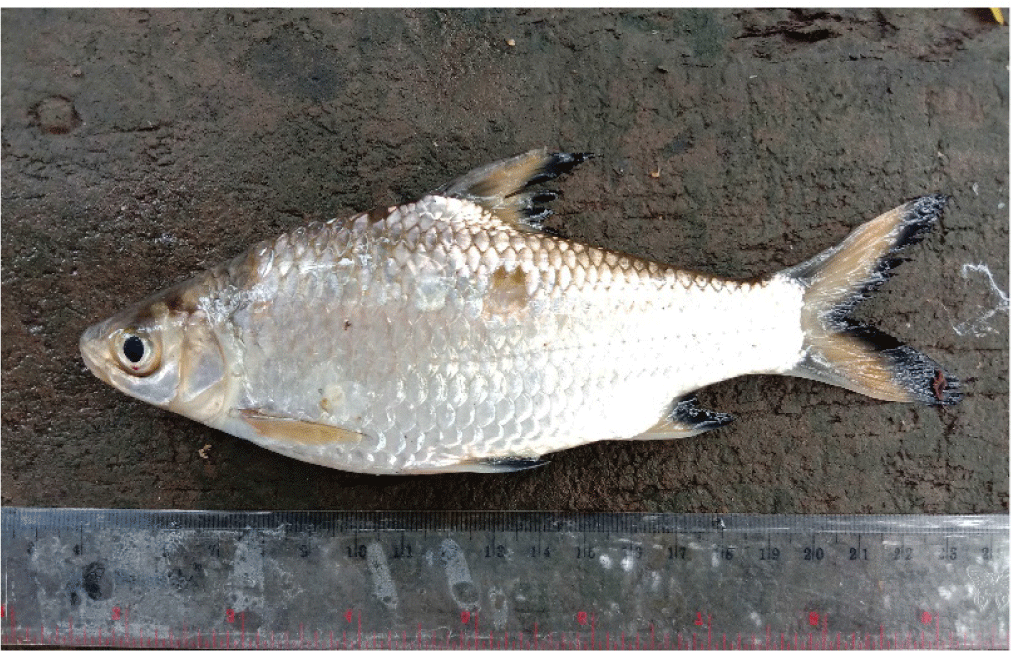
Barbus gonionotus Bleeker, 1849
Potamodromous, freshwater, brackish, benthopelagic, consumption fish, distributed throughout Mekong and Chao Phraya basins, Malay Peninsula, Indonesia (Sumatra and Java), found at Muara Angke Wildlife Reserve-MZB 26281 (Fig. 4; Kottelat et al., 1993; Wahyudewantoro et al., 2021).
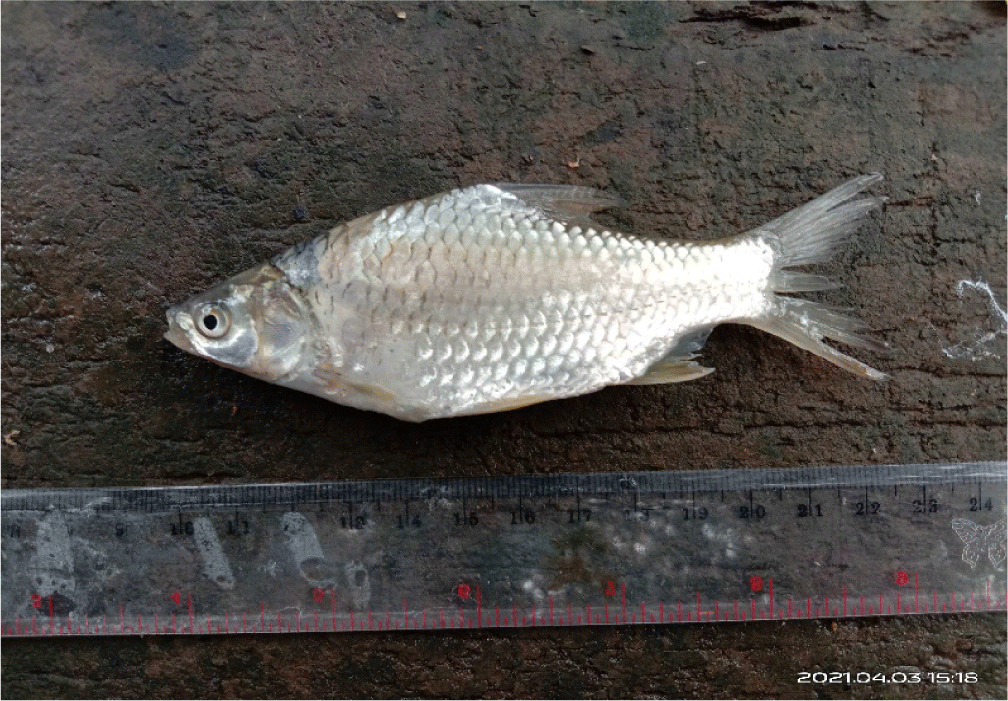
Leuciscus lateristriatus Bleeker, 1854
Freshwater, brackish, benthopelagic, ornamental fish, native fish, Sumatera, Kalimantan, Jawa, Bali, Lombok, and Sumbawa, recorded from Muara Angke Wildlife Reserve-MZB 26282 (Fig. 5; Kottelat et al., 1993; Wahyudewantoro et al., 2021, unpublished report).
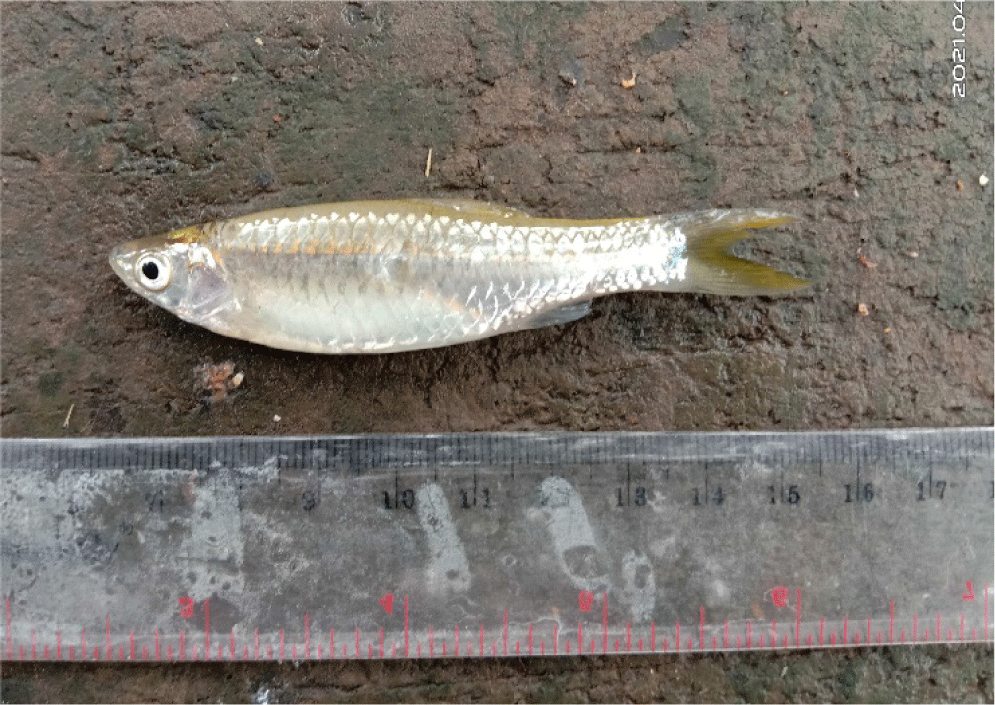
Bagrid catfish, euryhaline, freshwater, enter to brackish, widely distributed i.e Afrika and Asia, consumption fish (Ferraris, 2007; Fricke et al., 2018; Nelson et al., 2016).
Pimelodus gulio Hamilton, 1822
Anadromous, enter to freshwater and brackish, distributed throughout Indochina, India, and Indonesia (Sumatera, Jawa, and Kalimantan), recorded from Muara Angke Wildlife Reserve-MZB 26283 (Hossain et al., 2015; Wahyudewantoro et al., 2014).
Airbreathing labyrinthic organs arise from gill arches, walking catfish, and Freshwater, but often enter brackish water, Several species are known to be poisonous or venomous. distributed i.e. Afrika, then Syria, Southern and Western Asia (Kottelat et al., 1993; Nelson et al., 2016; Teugels, 2003).
Silurus batrachus Linnaeus, 1758
Walking catfish, Freshwater, brackish, potamodromous, important economical food, distributed throughout Indochina, Indonesia (Sundaland, introduced to Sulawesi), Philippines, Burma, India, found at Muara Angke Wildlife Reserve-MZB 26283 (Kottelat et al., 1993; Teugels, 2003; Wahyudewantoro et al., 2014).
Introduced, Freshwater, enter brackish, benthopelagic, potamodromous, aquaculture, distributed throughout Africa, almost found all of Pan-Africa, Asia, involve Jordan, Israel, Lebanon, Suriah and Turki Southside. Introduced to several countries. Found at Muara Angke Wildlife Reserve-MZB 26284 (Kottelat et al., 1993; Okeyo, 2003; Teugels, 2003; Wahyudewantoro et al., 2021).
Armored catfish, suckermouth, bony plates on the body, introduced, freshwater, brackish, distributed throughout Costarika, Panama, and South America (Bogan & Agnolin, 2019; Ferraris, 2007; Nelson et al., 2016).
Hypostomus pardalis Castelnau, 1855
Suckermouth, introduced, freshwater, enter to brackish, janitor fish, native to South America, and recorded can be found in almost all Indonesian public waters (registered as a pest), including Muara Angke Wildlife Reserve-MZB 26285 (Fig. 6; Armbruster, 2004; Nico et al., 2012; Wakida-Kusunoki et al., 2007; Wahyudewantoro et al., 2014; Wahyudewantoro & Rachmatika, 2016).
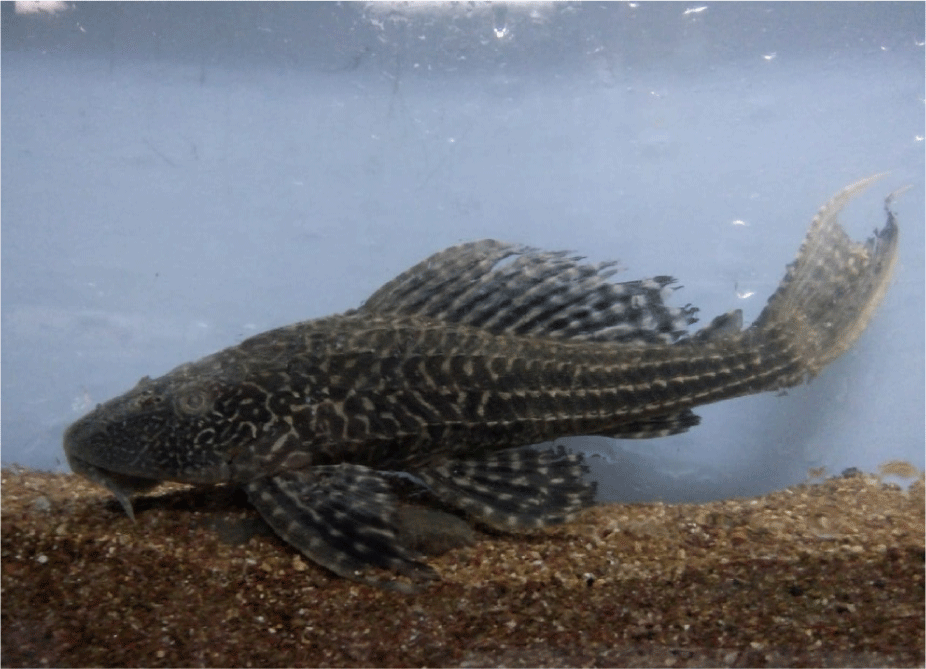
Halfbeaks, Freshwater and brackish, distributed throughout the Indo-West Pacific, three genera in Muara Angke Wildlife Reserve, Dermogenys, Zenarchopterus, and Hemiramphus (Huylebrouck et al., 2014; Lovejoy et al., 2004; Nelson et al., 2016; Wahyudewantoro et al., 2014).
Halfbeak, Marine, Freshwater, and Brackish, distributed throughout Myanmar, India, Laos, Thailand, Cambodia, Vietnam, Philippines, Malaysia, and Indonesia, found at Muara Angke Wildlife Reserve-MZB 26286 (Kottelat, 2013; Nelson et al., 2016; Simanjuntak, 2014).
Hemiramphus dispar Valenciennes, in Cuvier & Valenciennes, 1847
Marine, Freshwater, and Brackish distributed throughout Kenya, Mozambique, Seychelles, Madagascar, New Guinea, Solomon Islands (archipelago), Australia, New Caledonia, Fiji, Samoa, Sri Lanka, India, Malaysia, Thailand, Singapura and Vanuatu (Kottelat, 2013; Kottelat et al., 1993; Wahyudewantoro et al., 2014).
Asian rivulines, Freshwater, Brackish, Potential ornamental fish, distributed throughout Africa, southern North America, South America, southern Asia, and the Indo-Malaysian Archipelago (Froese & Pauly, 2021; Nelson et al., 2016).
Esox panchax Hamilton, 1822
Benthopelagic, Freshwater, Brackish, mosquito control, distributed throughout in Indo-Malaysian Archipelago, Vietnam, Cambodia, Sri Lanka, Pakistan, India, Bangladesh, Myanmar, and Nepal, found at Muara Angke Wildlife Reserve-MZB 26287 (Kottelat, 2013; Nelson et al., 2016; Wahyudewantoro et al., 2014).
Livebearers, Introduced, Freshwater, Brackish, mosquito control, native to the eastern United States, and northeastern Argentina, found in Africa and Madagascar, Now it has spread almost all over the country, including Indonesia (Lucinda, 2003; Nelson et al., 2016). Its presence has been considered a pest in some countries (Froese & Pauly, 2021).
Introduced, Benthopelagic, Freshwater, enter to brackish, mosquito control, native to northern Brazil, Venezuela, Barbados, Guyanas, and Trinidad, The spread almost all over worldwide, and is suspected to have become a pest, found at Muara Angke Wildlife Reserve-MZB 26287 (Lucinda, 2003; Wahyudewantoro & Rachmatika, 2016; Wahyudewantoro et al., 2014).
Introduced, Benthopelagic, Freshwater, Brackish, ornamental fish, native to North and Central America, several worldwide introduced species, including Indonesia, found at Muara Angke Wildlife Reserve-MZB 26288 (Maddern et al., 2011; Rachmatika & Wahyudewantoro, 2006; Wahyudewantoro et al., 2014).
Swamp eel, Freshwater, enter brackish, important consumption fish, distributed throughout to Indo-Australian Archipelago, Asia, Central and South America, Mexico, Western Africa, and Liberia (Allen et al., 2002; Nelson et al., 2016).
Bengal eel, Freshwater, Brackish, consumption fish, but rarely seen in the market, distributed in tropical water in Asia to Oceania, record from Muara Angke Wildlife Reserve-MZB 22142 (Kottelat et al., 1993; Wahyudewantoro et al., 2014).
Muarena alba Zuiew, 1793
Potamodromous, Freshwater, Brackish, rice paddy eels, consumption fish, distributed throughout Japan, China, India, Malaysia, and Indonesia, found at Muara Angke Wildlife Reserve-MZB 22142, 22147 (Froese & Pauly, 2021; Kottelat, 2013; Wahyudewantoro et al., 2014).
Glassfishes, Marine, Freshwater, and Brackish, found at Coral reefs, are distributed throughout to Indo-West Pacific, Asia, and Oceania (Allen et al., 2002; Froese & Pauly, 2021).
Malabar glassy perchlet, Marine, Freshwater, Brackish, rarely seen in the market, distributed Indo-West Pacific, found at Muara Angke Wildlife Reserve-MZB 26303 (Fig. 7; Kottelat, 2013; Wahyudewantoro et al., 2014; White et al., 2013).
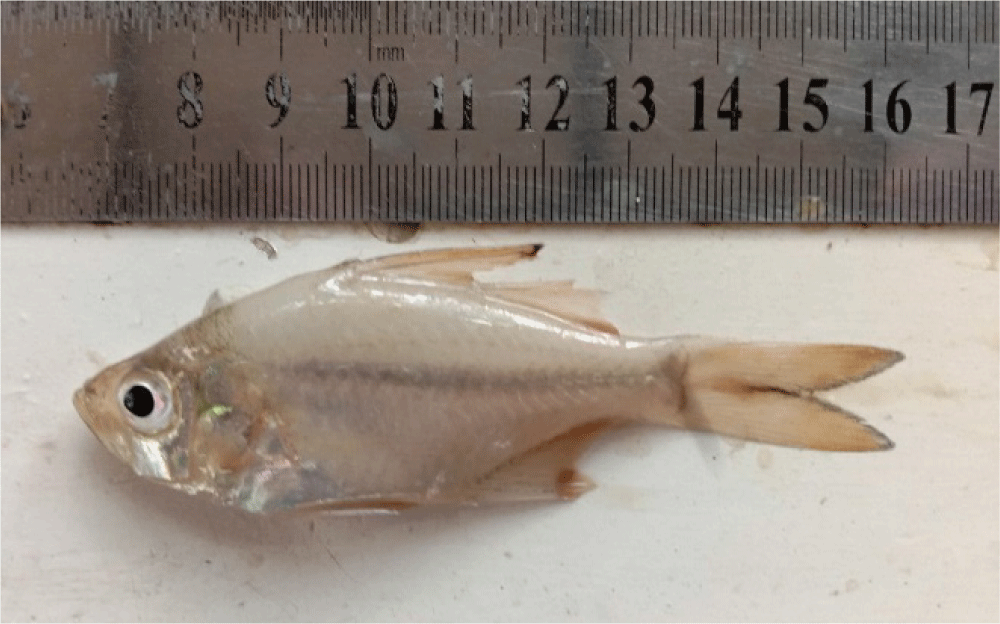
Lutjan gymnocéphale La Cepéde, 1802
Amphidromous, Marine, Freshwater, Brackish, consumption fish, distributed throughout South Africa to the Philippines, north to Taiwan, and south to Australia, found at Muara Angke Wildlife Reserve-MZB 26289 (Fig. 8; Kottelat, 2013; Wahyudewantoro et al., 2014; White et al., 2013).
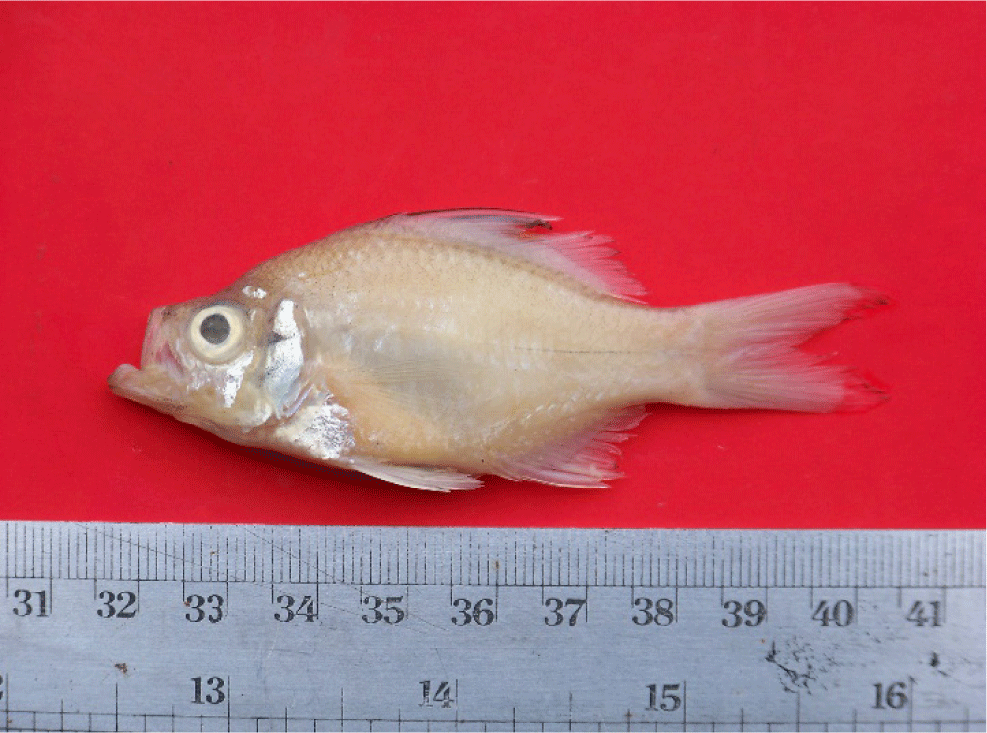
Amphidromous, Marine, Freshwater, and Brackish, distributed throughout to Philippines, New Guinea, Vanuatu, New Caledonia, northern Australia, Indo-Australian Archipelago, including Indonesia, and Andaman Sea, found at Muara Angke Wildlife Reserve-MZB 26290 (Froese & Pauly, 2021; Kottelat et al., 1993; Wahyudewantoro et al., 2014).
Jack and Pompanos, Marine, juvenile sometimes goes into brackish, important consumption fish, distributed throughout to Atlantic, Indian, and Pacific Seas (Nelson et al., 2016; Peristiwady, 2006).
Amphidromous, Marine, Freshwater, Brackish, potential consumption fish, distributed throughout to Indo-Pacific and Eastern-Pacific, found at Muara Angke Wildlife Reserve-MZB 26291 (Kottelat et al., 1993; Peristiwady, 2006; Wahyudewantoro et al., 2014; White et al., 2013).
Ponyfishes, Silverbellies, Slipmouths, Slimys, and Euryhaline, enter brackish, consumption fish, distributed throughout the Indo-West Pacific (Nelson et al., 2016; Sparks & Dunlap, 2004).
Scomber equula Forskål, 1775
Amphidromous, Marine, freshwater, brackish, consumption fish, distributed throughout Indo-West Pacific, found at Muara Angke Wildlife Reserve-MZB 26292 (Kottelat, 2013; Peristiwady, 2006; Wahyudewantoro et al., 2014).
Scats, Euryhaline, Marine, and Brackish, enter freshwater, potentially consumption, distributed throughout the Indo-West Pacific (Froese & Pauly, 2021; Peristiwady, 2006; White et al., 2013).
Chaetodon Argus Linné, 1766
Amphidromous, Marine, Freshwater, and Brackish, found at coral reefs, distributed throughout the Indo-Pacific, from Kuwait to Australia and Japan, found at Muara Angke Wildlife Reserve-MZB 26293 (Allen et al., 2002; Mujadid et al., 2020; Simanjuntak, 2014; Wahyudewantoro et al., 2014).
Snappers, Euryhaline, and juvenile enter brackish, potentially consumption fish, distributed throughout the Atlantic, Indian, and Pacific Seas (Froese & Pauly, 2021; Nelson et al., 2016; Rajan, 2018).
Sciaena argentimaculata Forskål, 1775
Oceanodromous, juvenile and young adults enter brackish and freshwater, important economic fish, distributed throughout Indo-West Pacific, record from Muara Angke Wildlife Reserve-MZB 26294 (Peristiwady, 2006; Riede, 2004; Wahyudewantoro et al., 2014; White et al., 2013).
Mojarras, tropical seas, juvenile enter to brackish and freshwater, found in all coastal waters in Indonesia (Chi-Espínola et al., 2018; Kottelat et al., 1993).
Labrus öyena Forskål, 1775
Marine, enter to brackish and freshwater, consumption fish, distributed throughout Indo-Pacific, found at Muara Angke Wildlife Reserve-MZB 26295 (Kottelat et al., 1993; Wahyudewantoro et al., 2014).
Croakers, drums, and Euryhaline enter brackish and freshwater, reef-associated, important economic fish, distributed throughout the Atlantic, Indian, and Pacific oceans (Kottelat et al., 1993; Nelson et al., 2016).
Corvina Belengerii Cuvier, in Cuvier & Valenciennes, 1830
Amphidromous, Marine, Freshwater, and Brackish, consumption fish, distributed throughout the Indo-West Pacific, recorded to Muara Angke Wildlife Reserve-MZB 26296 (White et al., 2013; Wahyudewantoro et al., 2014).
Cichlids, Freshwater, Brackish, most popular aquarium fish, found in the lowland, freshwater areas of tropical and subtropical regions, distributed throughout Central and South America, Texas (only 1 species), Africa, Madagascar, Israel, Srilanka, Iran, West Indies, and coastal Southern India, several species introduced worldwide (Berra, 2001; Kullander, 2003; Nelson et al., 2016).
Chromis mossambicus Peters, 1852
Introduced, Amphidromous, Freshwater, brackish, consumption fish, native to Africa, record from Muara Angke Wildlife Reserve-MZB 26297 (Mujadid et al., 2020; Riede, 2004; Wahyudewantoro et al., 2014).
Perca nilotica Linnaeus, 1758: 290
Introduced, Potamodromous, Freshwater, Brackish, aquaculture fish, native to Africa Freshwater, brackish, benthopelagic, potamodromous, record from Muara Angke Wildlife Reserve-MZB 26298 (Mujadid et al., 2020; Riede, 2004; Wahyudewantoro et al., 2014).
Mullets, Marine, Freshwater, and Brackish, distributed throughout all tropical and temperate seas, are found in Indonesian waters (Kottelat et al., 1993; Nelson et al., 2016).
Mugil subviridis Valenciennes, in Cuvier & Valenciennes, 1836
Catadromous, Marine, freshwater, brackish, consumption fish, distributed throughout the Indo-Pacific, found at Muara Angke Wildlife Reserve-MZB 26299 (Froese & Pauly, 2021; Mujadid et al., 2020; Wahyudewantoro et al., 2014).
Mugil crenilabis tâde Forskål, 1775
Marine, Freshwater, and Brackish, distributed throughout the Indo-West Pacific, found at Muara Angke Wildlife Reserve-MZB 26300 (Fig. 9; Durand et al., 2017; Peristiwady, 2006; Wahyudewantoro et al., 2021).
Ricefishes, Freshwater, enter brackish, distributed throughout Japan to the Indo-Australian Archipelago, and India (Kottelat et al., 1993; Nelson et al., 2016; Parenti & Hadiaty, 2010).
Aplocheilus javanicus Bleeker, 1854x: 323
Freshwater enters brackish, ornamental fish potential, distributed throughout Malaysia, Singapore, Peninsular Thailand, and Indonesia, found at Muara Angke Wildlife Reserve-MZB 26301 (Froese & Pauly, 2021; Kottelat et al., 1993; Wahyudewantoro et al., 2021).
Butid sleepers, Freshwater, Brackish, included in the 8 members of Gobioidae i.e Rhyacichthyidae, Milyeringidae, Odontobutidae, Eleotrididae, Thalasseleotrididae, Gobionellidae, and Gobiidae. distributed throughout the tropical sea in the Indo-Pacific and West Africa (Nelson et al., 2016).
Eleotris porocephala Valenciennes, 1837
Amphidromous, Marine, Freshwater, and Brackish, important consumption fish, distributed throughout the tropical Indo-west Pacific, and northern Australia, found at Muara Angke Wildlife Reserve (Allen et al., 2002; Froese & Pauly, 2021; Wahyudewantoro et al., 2014).
Eleotris marmorata Bleeker
Potamodromous, Freshwater, enter to brackish, important consumption fish, distributed throughout Cambodia, Thailand, Laos, Vietnam, Malaysia, Philippines, Brunei Darussalam, and Indonesia (including at Muara Angke Wildlife Reserve) (Fricke et al., 2018; Kottelat et al., 1993; Simanjuntak, 2014; Wahyudewantoro et al., 2014).
Gobies, Anadromous, Catadromous, Marine, Freshwater, and Brackish, are distributed throughout mainly tropical and subtropical water (Kottelat et al., 1993; Nelson et al., 2016).
Ctenogobius krajiensis Herre, 1940
Anadromous, Marine, and Brackish enter the downstream part of the river, distributed throughout Singapore and Indonesia, recorded at Muara Angke Wildlife Reserve (Kottelat et al., 1993; Wahyudewantoro et al., 2014).
Gobius giuris Hamilton, 1822
Amphidromous, Marine, Brackish, Freshwater, distributed throughout tropical Indo-West Pacific, coastal from austral Africa, Madagascar, India, and southern China, found at Muara Angke Wildlife Reserve-MZB 26302 (Hoese & Hammer, 2021; Kottelat, 2013; Simanjuntak, 2014; Wahyudewantoro et al., 2021).
Gobionellus, Mudskippers, Amphibious fish, can be found in almost all temperate and tropical waters (Nelson et al., 2016).
Gobius boddarti Pallas, 1770
Amphidromous, Marine, Brackish, Freshwater, associated with mangroves, distributed throughout the Indo-West Pacific, found at Muara Angke Wildlife Reserve (Kottelat, 2013; Kottelat et al., 1993; Wahyudewantoro et al., 2014).
Gobius schlosseri Pallas, 1770
Giant Mudskipper, Amphidromous, Marine, Brackish, lower reaches of rivers, distributed throughout Indo-West Pacific, found at Muara Angke Wildlife Reserve-MZB 24637 (Kottelat et al., 1993; Wahyudewantoro et al., 2014, 2021).
Climbing gouramies, Freshwater, enter brackish, consumption fish, distributed throughout African public waters, India to the Philippines (Berra, 2001; Kottelat et al., 1993; Nelson et al., 2016).
Anthias testudineus Bloch, 1792
Potadromous, Freshwater, Brackish, often found in the mouth of the river, Economic foodfish, distributed throughout native to Asia, India to China, and Wallace line, found at Muara Angke Wildlife Reserve-MZB 24624 (Froese & Pauly, 2021; Kottelat et al., 1993; Wahyudewantoro et al., 2014).
Fighting fishes, Gouramies, and Freshwater, enter to brackish, breathe air directly from the atmosphere, distributed throughout tropical public waters in Pakistan, China, Korea, India, the Malay Archipelago, and Indonesia (Berra, 2001; Kottelat et al., 1993).
Labrus trichopterus Pallas, 1770
Potadromous, Freshwater, enter to brackish, Benthopelagic, potential as ornamental fish and consumption, distributed throughout public waters in Asia, including Southeast Asia, found at Muara Angke Wildlife Reserve-MZB 24626, 24627, 24628, 24629 (Froese & Pauly, 2021; Kottelat, 2013; Wahyudewantoro et al., 2014).
Snakeheads, Freshwater, Brackish, and air-breathing, are distributed throughout public waters in Africa and Southern Asia (Froese & Pauly, 2021; Nelson et al., 2016).
Ophicephalus striatus Bloch, 1793
Potadromous, Freshwater, Brackish, foodfish, and fish albumin extract for medicine, distributed throughout native to South and Southeast Asia (Kottelat, 2013; Kottelat et al., 1993; Mujadid et al., 2020; Simanjuntak, 2014; Wahyudewantoro et al., 2014).
Triple spines, Marine, enter to brackish, distributed throughout the Indo-Pacific (Nelson et al., 2016; White et al., 2013).
Balistes biaculeatus Bloch, 1786
Euryhaline, enters brackish and mangrove water, distributed throughout the Indo-West Pacific, found at Muara Angke Wildlife Reserve (Froese & Pauly, 2021; Kottelat, 2013; Wahyudewantoro et al., 2014).
Discussion
Muara Angke Wildlife Reserve as a conservation place is inhabited by a variety of animals, both terrestrial and aquatic. In general, this area is dominated by various types of mangrove plants. In the following study, it was revealed that 43 species were belonging to 29 families and 39 genera (Table 1). The number of these fish species is higher, as many as 12 species are collected in the Gunung Sawal-Tasikmalaya Wildlife Reserve and 22 species in Cikepuh-Sukabumi, West Java (Haryono, 2017; Supriyani, 2010).
The types of fish in the Muara Angke Wildlife Reserve are fish that can live, adapt, and breed in an aquatic environment with a high salinity level. Several studies on the variety of fish species in the reserve have been carried out; among others, in 2012, 32 species of fish belonging to 29 genera, 26 families, and 1,535 individuals were obtained; in 2013, only 8 species of fish were found, representing 8 genera, 8 families, and 74 individuals; and in 2019, the identification of 10 families and 167 individuals were recorded (Mujadid et al., 2020; Simanjuntak, 2014; Wahyudewantoro et al., 2014). Meanwhile, there was no data on the types of fish that inhabited the area in previous years.
The Cyprinidae family has the highest species with 4 species (9.76%) and Ambasisdae 3 species (7.32%). The family updates for the fish species that inhabit the waters in this sanctuary are Zenarchopteridae, which was previously Hemiramphidae, then Ambassidae, previously Chandidae, Butidae, previously Eleotrididae, Oxudercidae which is a sub of Gobiidae which later became independent and Osphronemidae previously Belontiidae (Allen et al., 2002; Fricke et al., 2018; Kottellat, 2013; Kullander, 2003; Weber, 1916). In addition, species discovered have validated synonymous names as presented in Table 2.
Furthermore, updated data was contributed from Cyprinidae, where for Cyprinidae there is a new record of the species of fish Balashark Balantiocheilos melanopterus distribution in Sumatra and Kalimantan (Wahyudewantoro et al., 2021) and also the Muara Angke Wildlife Reserve (Wahyudewantoro et al., 2022). This fish entering the waters of this sanctuary is suspected to have been released from the fish breeding place. In addition, the tawes fish species Barbonymus gonionotus and wader pary R. latereristriata have never been caught in these waters (Mujadid et al., 2020; Simanjuntak, 2014; Wahyudewantoro et al., 2014).
After further investigation, seven species were introduced: carp Cyprinus carpio, lele dumbo Clarias gariepinus, mujaer Oreochromis mossambicus, nila Oreochromis niloticus, sapu-sapu Pterygoplicthys pardalis, gapi Poecilia reticulata, and plati Xiphophorus helleri. The presence of introduced fish such as tilapia and mujaer is closely related to increasing food production, while gapi and plati are more for controlling mosquito larvae. The sapu-sapu were originally used as glass-cleaning ornamental fish (Herder et al., 2012: Ribeiro et al., 2009; Wahyudewantoro & Rachmatika, 2016). However, these species’ existence is currently thought to impact native fish in the area negatively.
In general, the waters of the Muara Angke Wildlife Reserve are brackish or have salinity levels ranging from 1 to 3.76 ppt. The species of fish that inhabit these waters are 5 species, 12.20% are freshwater fish, and 36 species, 87.80% are euryhaline. Seeing the species of freshwater fish found in saline waters, it is suspected that there is an adaptation pattern for these types of fish to survive in these waters. Yulan et al. (2013) argue that the salinity contained in water will affect the survival of the aquatic fauna in it. Looking at the existing migration patterns, it is suspected that it is related to the character of each type of fish and the function of mangroves as a place for foraging, nurturing, and breeding several types of fauna (Nagelkerken et al., 2000; Wahyudewantoro, 2018).
Based on the ecological characteristics of these waters, it can be seen that Indonesia’s smallest wildlife reserve area is unique based on its location amid rapid urban development in the country. The phenomenon of microplastic pollution and anthropogenic changes pose challenges to the existence of the Muara Angke Wildlife Reserve area. However, its existence is essential for sustainable biodiversity and as the city’s lungs to prevent global warming due to climate change occurring today.
Furthermore, as a reserved area, it should be clean or not polluted by the presence of introduced fish species, but there were seven (14.63%) fish that were not from Indonesia. After being studied ecobiologically, one species, namely sapu-sapu P. pardalis, entered into an invasive fish species (Wahyudewantoro & Rachmatika, 2016). The presence of these types of fish is suspected to have been released or separated from the upstream direction of the river, this is because the location of this reserve is downstream of several rivers in DKI Jakarta including the Krukut, Pesanggrahan, Grogol, Manggarai, and Ciliwung rivers (Mujadid et al., 2020; Purwoko et al., 2015). Three species of introduced fish exist, namely gapi Poecilia reticulata, sewu X. hellerii, and louhan Amphilophus trimaculatum swimming freely in inland waters in Gunung Sawal SM (Haryono, 2017).
Inland water areas, especially the Muara Angke Wildlife Reserves, should receive more attention for the preservation of flora and fauna. To support the sustainability of biodiversity in inland water areas, the involvement of all parties is needed. Furthermore, sustainability of fisheries resources and an area-based fisheries management approach could be an option. Especially in dealing with the invasion of introduced or invasive fish in Indonesia, where it is necessary to monitor related parties so that the population can be controlled. It is hoped that by preserving the ecosystem and its natural habitat, the existence of native fish will remain sustainable and survive.
Conclusion
Muara Angke Wildlife Reserves have six newly mapped families: Engraulidae, Zenarchopteridae, Ambassidae, Butidae, Oxudercidae, and Osphronemidae. The Cyprinidae and Ambassidae families are the families with the largest species. In addition, seven introduced species completed the area’s fish diversity, and thirty-three synonyms were validated with major references Froese & Pauly (2021). It is hoped that biodiversity, especially fish will become a common concern for all parties to be actively involved in maintaining the sustainability of fisheries resources.

